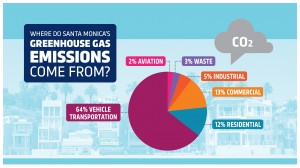Cities Heading to 100% Renewable Power
 This past week, my EcoMotion colleagues Michael Ware and Drew Lowell-Britt headed to the Santa Monica Annenburg Beach House for a Climate Action Plan (CAP) meeting, a meeting of the minds. Three cheers: The City’s 15×15 CAP exceeded its own goals. Instead of achieving reductions of 15% below 1990 levels in municipal operations and community wide, the City has achieved a 20% reduction. Now it is headed to net zero.
This past week, my EcoMotion colleagues Michael Ware and Drew Lowell-Britt headed to the Santa Monica Annenburg Beach House for a Climate Action Plan (CAP) meeting, a meeting of the minds. Three cheers: The City’s 15×15 CAP exceeded its own goals. Instead of achieving reductions of 15% below 1990 levels in municipal operations and community wide, the City has achieved a 20% reduction. Now it is headed to net zero.
So, how can any city, in this case Santa Monica, go from 20% below 1990 levels to zero carbon? The power sector is greening on its own and with marked results. Transport accounts for 64% of the City’s current footprint. EVs – battery and hydrogen fuel-cell powered EVs – have the potential to cut that carbon. Will we have enough “spill-over” renewables – having fully satisfied our demand for electricity – that we can power our transportation sector?
This issue also arose for water and space heating in Santa Monica. Will we have enough “extra” renewable power for additional purposes? Traditionally, direct combustion of a fuel is more thermodynamically efficient than using electricity. But now, with an electrified society, electric water heat pumps, electric cooktops, and electric heating systems make sense as next steps in the quest for carbon zero. The Stone Edge Farm in Sonoma, an experimental microgrid, is fully powering its facilities and now electrolyzing water to create hydrogen fuel for one of its vehicles.
Imagine a city, your city, powered exclusively by renewable resources. It will likely have to be a mix of renewables. This diversity addresses intermittency. The sun shines during the day, wind in the interior of our nation blows at night. Coastal states’ wind farms provide power in the mornings and evenings, power shifting due to coastal and desert temperature differentials. Other renewables operate like baseload power plants, they can run all the time, or can be “ramped” up and down as needed. These include geothermal hydro plants, methane-fueled microturbines, and biomass plants.
Imagine no more coal, and no more natural gas or nuclear either. To be in the “100% club” you have to pledge to get it all from renewables. And guess what? Already, nearly 100 cities around the world have made the pledge, including San Francisco, San Diego, San Jose, Rochester, Minnesota, and more. Many plan to do so by 2035. All hope to do so at zero marginal cost… at parity with current power prices.
Some cities have already done it! Burlington, Vermont has been given lots of notoriety for its 100% renewable power generation and use. Its wood chip plant provides its base load power; then it has solar, wind, and hydro. Aspen, Colorado also achieved the 100% goal in 2015 with its own hydro plant providing 50% of its generation.
In the fall of 2016, the City of Los Angeles City Council passed a resolution for its municipal utility – LADWP – to study the path to 100% renewable by 2035. Consider the magnitude of the task: Each year Los Angeles Department of Water and Power sells about 25,000 GWh of power. Currently, 20% of that, or 5,000 GWh, is renewable. By 2020, 33% of the power will be renewable. Right now, 40% is coal-fired, 22% is natural gas, and 9% is nuclear. Together with maximizing energy efficiency, the City will have to completely replace these sources with a mix of power that fulfills demand 24/7.
One of the tools that will help cities get to 100% cost-effectively is energy storage. Storage provides a means to buy cheap power at night – say wind from the Midwest – and to use it during peak periods. The City of Los Angeles has a 1.6 GW pumped storage system that can provide 20% of system capacity for up to six hours. Envision doubling this so that LA becomes the nation’s storage capitol, able to tap the lowest-cost renewables for peak power use. These storage systems can also provide “ancillary services” to the grid, stabilizing the frequency… as resources change and as consumption changes.
To transform a city of four million people – like Los Angeles – with major buildings, industries, oil refineries, airports, etc. – to 100% renewable will be herculean. It will require participation in energy efficiency initiatives the likes of which we have never seen before, with retrofits that get deep penetration. I propose a city that is 20% more efficient. We propose solar generation to be ubiquitous on our rooftops, over parking lots, on building facades; even north-facing rooftops! Storage will be embedded in our garages, in our communities, and at utility power plants and substations. And also powering our city will be renewables in our deserts, from states afar, and potentially offshore.
